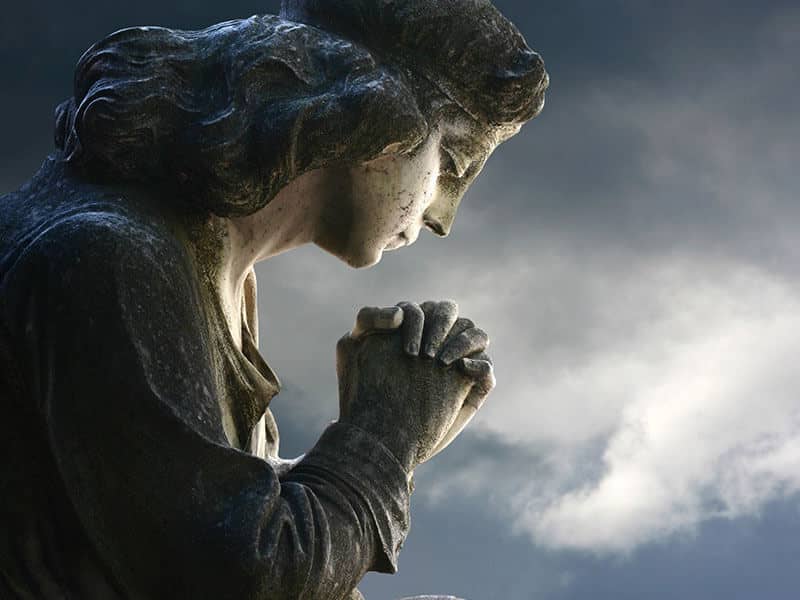
What do angels look like?
I often receive emails asking, "Please tell me what my angel looks like." Often the questioner has been listening to someone on radio or TV describe their "vision" of angels surrounding members of the audience. Can people really see angels around a person? The Bible and the mainstream Christian faith know nothing of such second sight. It would be interesting to have three people, who claim to have the power to see a person’s angels, write down their descriptions and then compare them. I have no doubt they would describe three different entities!
Why? Because in their natural form angels are spirit beings, and our physical eyes cannot see the spirit. It also does not make sense that one’s angel (or three angels, as some claim we all have) would always be standing right behind their charge. In the Bible we learn that angels can move with tremendous speed, so guardian angels could keep their watch even if they were 50 or 100 feet above their charge.
Angels do have the ability to assume temporarily a shape that humans can see when there is a reason for them to do so. Most often in the Bible and in life today, when angels are seen they appear as people, looking no different than other persons. Remember Abraham’s visitors in Genesis 18? Hebrews 13:2 also states, "Be not forgetful to entertain strangers: for thereby some have entertained angels unawares." The passage suggests that at any time it is possible that we may have encountered angels without our being conscious of their supernatural nature. Being inconspicuous is often a part of the angel’s ministry.
Most often, as angels do their work, they remain unseen. I am certain that when we get to heaven we will be amazed at how often angels were present and active in our lives though we were not aware of their activity.
Of course, there are exceptions. In biblical times and in life today, sometimes the angels appear in awesome splendor. They may appear as warrior angels, tremendously tall and powerful, or as beautiful beings with or without wings. In Psalm 104:4 angels are described as a flaming fire. Many have told us that they have seen an angel appear as light. At times the light appears as a faint glow that grows until the room is filled with brilliance. At other times it is an unseen figure bathed in light. Some have been only able to describe what an angel was wearing because the face was bathed in a such a bright light that it could not be seen. For some observers, the light is pure and white, brighter than any whiteness they have ever seen; others describe a light of different colors.
Genderless splendor?
Read more on page 2 >>
| _Related Features | |
|
| |
 |
Many who have been by the bedside of a dying loved one tell of a light that entered the room in the final moments of life. The light seemed to gently rise as though escorting the unseen spirit of the dying person into the presence of God.
So what do angels look like? They are unseen spirits that may take on human form only in certain circumstances, as a temporary accommodation to human needs.
Are angels male or female?
This is the question children ask most often. Many of the pictures we see of angels, especially those on Christmas cards, are of a woman with long blond hair, dressed in a flowing white robe and with graceful wings.
But are angels mostly women? No! They are neither men nor women. They do not have a gender as we know it. They do not marry or have children (Matthew 22:28-30); they are sexless beings, at least in the normal sense of the word. It is possible that celestial beings have a gender in a way unknown to us. C.S. Lewis speculated about this in his fictional space trilogy, Perelandra.
What we do know is that angels are not masculine or feminine in the way we use those terms. When I sit on the floor surrounded by five-year-old children who ask that question in Sunday School, I simply answer, "Angels are not boys or girls. They are different than people. Different and wonderful."
Don’t all angels in the Bible have masculine names?
Whenever I am leading a seminar on angels and this question is raised, I ask: "What are the names of angels in the Bible?"
The answers come quickly: "Gabriel and Michael."
"That’s right," I answer. "Are there others?"
For a long moment, there is usually silence before someone calls out the name of Lucifer, the fallen angel. These three are the only angels named in the Bible. The Apocrypha adds Raphael, and Uriel is also mentioned in Jewish, Kabbalistic, and some Christian traditions. The Kabbalah includes many other angel names, most ending in -el, from the Hebrew root indicating "God." These names are all masculine.
I can picture the angels chuckling about our speculation over their names. Since there are millions and millions of angels and we only know the names of a few, we certainly cannot draw any conclusion about the gender of angels based on their names. We are limited to a human vocabulary. It is quite possible that countless angels have wonderful names we have never heard on earth, names that are truly angelic but neither masculine nor feminine.
| _Related Features | |
|
| |
 |

